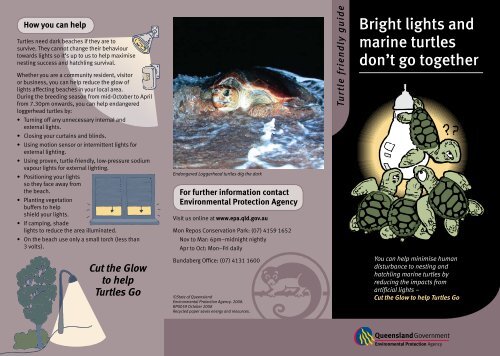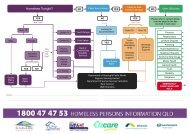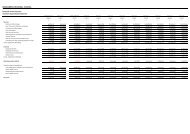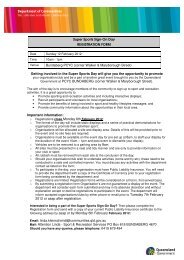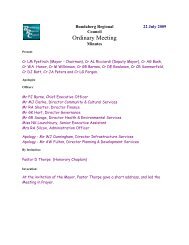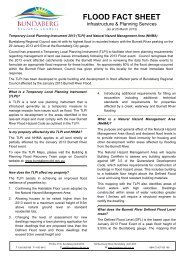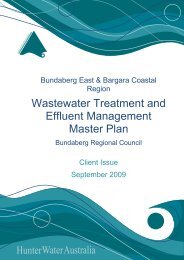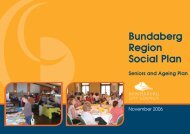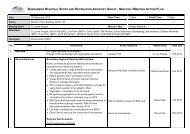Cut the glow to help turtles go
Cut the glow to help turtles go
Cut the glow to help turtles go
You also want an ePaper? Increase the reach of your titles
YUMPU automatically turns print PDFs into web optimized ePapers that Google loves.
How you can <strong>help</strong><br />
Turtles need dark beaches if <strong>the</strong>y are <strong>to</strong><br />
survive. They cannot change <strong>the</strong>ir behaviour<br />
<strong>to</strong>wards lights so it’s up <strong>to</strong> us <strong>to</strong> <strong>help</strong> maximise<br />
nesting success and hatchling survival.<br />
Whe<strong>the</strong>r you are a community resident, visi<strong>to</strong>r<br />
or business, you can <strong>help</strong> reduce <strong>the</strong> <strong>glow</strong> of<br />
lights affecting beaches in your local area.<br />
During <strong>the</strong> breeding season from mid-Oc<strong>to</strong>ber <strong>to</strong> April<br />
from 7.30pm onwards, you can <strong>help</strong> endangered<br />
loggerhead <strong>turtles</strong> by:<br />
• Turning off any unnecessary internal and<br />
external lights.<br />
• Closing your curtains and blinds.<br />
• Using motion sensor or intermittent lights for<br />
external lighting.<br />
• Using proven, turtle-friendly, low-pressure sodium<br />
vapour lights for external lighting.<br />
• Positioning your lights<br />
so <strong>the</strong>y face away from<br />
<strong>the</strong> beach.<br />
• Planting vegetation<br />
buffers <strong>to</strong> <strong>help</strong><br />
shield your lights.<br />
• If camping, shade<br />
lights <strong>to</strong> reduce <strong>the</strong> area illuminated.<br />
• On <strong>the</strong> beach use only a small <strong>to</strong>rch (less than<br />
3 volts).<br />
<strong>Cut</strong> <strong>the</strong> Glow<br />
<strong>to</strong> <strong>help</strong><br />
Turtles Go<br />
Endangered Loggerhead <strong>turtles</strong> dig <strong>the</strong> dark<br />
For fur<strong>the</strong>r information contact<br />
Environmental Protection Agency<br />
Visit us online at www.epa.qld.<strong>go</strong>v.au<br />
Mon Repos Conservation Park: (07) 4159 1652<br />
Nov <strong>to</strong> Mar: 6pm–midnight nightly<br />
Apr <strong>to</strong> Oct: Mon–Fri daily<br />
Bundaberg Office: (07) 4131 1600<br />
©State of Queensland<br />
Environmental Protection Agency. 2008.<br />
BP0059 Oc<strong>to</strong>ber 2008<br />
Recycled paper saves energy and resources.<br />
Turtle friendly guide<br />
Bright lights and<br />
marine <strong>turtles</strong><br />
don’t <strong>go</strong> <strong>to</strong>ge<strong>the</strong>r<br />
You can <strong>help</strong> minimise human<br />
disturbance <strong>to</strong> nesting and<br />
hatchling marine <strong>turtles</strong> by<br />
reducing <strong>the</strong> impacts from<br />
artificial lights –<br />
<strong>Cut</strong> <strong>the</strong> Glow <strong>to</strong> <strong>help</strong> Turtles Go
Lights and Turtles<br />
Nesting and hatchling marine <strong>turtles</strong> are disoriented by<br />
bright lights. Artificial lights interfere with <strong>the</strong>ir natural<br />
habits and instincts, resulting in negative impacts on<br />
<strong>the</strong> population. Marine <strong>turtles</strong> are threatened species<br />
— <strong>the</strong>y need our <strong>help</strong> <strong>to</strong> survive.<br />
Why are lights a problem?<br />
It is no accident that <strong>the</strong> majority of both nesting and<br />
hatchling turtle activity occurs at night. Disturbances<br />
and danger from preda<strong>to</strong>rs, both on land and at sea,<br />
is lowest under <strong>the</strong> cover of darkness. Artificial light<br />
disturbance can be from a single light directly opposite<br />
a nesting beach or from <strong>the</strong> collective <strong>glow</strong> of lights<br />
from a coastal community. If nesting areas become<br />
bright from artificial lights, female <strong>turtles</strong> may change<br />
<strong>the</strong>ir nesting beach. This may lead <strong>to</strong> <strong>turtles</strong> nesting<br />
in unsuitable locations, resulting in reduced egg<br />
production and hatchling survival. Bright artificial<br />
lights also cause hatchlings <strong>to</strong> become disorientated<br />
which significantly impacts <strong>the</strong>ir chances of survival.<br />
Turtles in trouble<br />
Breeding female <strong>turtles</strong> migrate back <strong>to</strong> <strong>the</strong> general<br />
area of <strong>the</strong>ir birth <strong>to</strong> nest. Turtles choose <strong>the</strong>ir nesting<br />
beach while still offshore before coming on land <strong>to</strong><br />
lay <strong>the</strong>ir eggs, and will usually remain loyal <strong>to</strong> that<br />
selected beach. However, if coastal communities emit<br />
bright artificial lights and <strong>glow</strong>s above <strong>the</strong> beaches,<br />
<strong>the</strong> <strong>turtles</strong> may move <strong>to</strong> a darker beach. This can<br />
be a problem as not all beaches are <strong>go</strong>od incuba<strong>to</strong>rs<br />
for turtle eggs. Some beaches are open <strong>to</strong> <strong>the</strong> elements<br />
and erosion can affect nests; o<strong>the</strong>rs are rockier, making it<br />
harder for <strong>turtles</strong> <strong>to</strong> dig <strong>the</strong>ir nests causing <strong>the</strong>m <strong>to</strong> waste<br />
valuable energy with each attempt.<br />
After hatchlings emerge from <strong>the</strong>ir nests at night, <strong>the</strong>y find<br />
<strong>the</strong>ir way <strong>to</strong> <strong>the</strong> sea by moving <strong>to</strong>wards <strong>the</strong> lightest horizon<br />
as <strong>the</strong>y see it. Under natural conditions, this is over <strong>the</strong><br />
ocean and hatchlings will quickly travel down <strong>the</strong> beach<br />
in<strong>to</strong> <strong>the</strong> water, heading for <strong>the</strong> strong coastal currents <strong>to</strong><br />
carry <strong>the</strong>m in<strong>to</strong> deeper water where <strong>the</strong>y can mature.<br />
Unfortunately, on nesting beaches near <strong>to</strong>wns, resorts<br />
and camping areas, artificial lights can mask a turtle’s<br />
capacity <strong>to</strong> see <strong>the</strong> natural horizon. In <strong>the</strong>se unnatural<br />
situations, hatchlings can become disoriented, veering<br />
from <strong>the</strong>ir natural path and heading <strong>to</strong>wards <strong>the</strong> artificial<br />
light source, lessening <strong>the</strong>ir chances of survival.<br />
Even hatchlings that have made it <strong>to</strong> <strong>the</strong> sea can<br />
be enticed back <strong>to</strong> land by strong coastal lights.<br />
As <strong>the</strong> dawn approaches and <strong>the</strong> contrast<br />
between artificial and natural light decreases,<br />
<strong>the</strong> hatchlings will usually turn from <strong>the</strong><br />
artificial lights and head <strong>to</strong>wards <strong>the</strong> sea, unfortunately<br />
with a greater risk of bird predation. Many will not make<br />
it as <strong>the</strong>y have become trapped in vegetation, or <strong>the</strong>y<br />
have wasted energy reserves due <strong>to</strong> <strong>the</strong>ir extended<br />
wanderings. As <strong>the</strong> day progresses, hatchlings caught<br />
on shore may overheat and die.<br />
In <strong>the</strong> natural scheme of things, turtle hatchlings are<br />
already at considerable risk. Disrupting <strong>the</strong>ir lifecycle<br />
during this critical stage can have drastic effects on <strong>the</strong>ir<br />
survival rates. If insufficient numbers of hatchlings from<br />
a nesting area survive <strong>to</strong> maturity, <strong>the</strong> continuity of that<br />
breeding population itself is in jeopardy.


